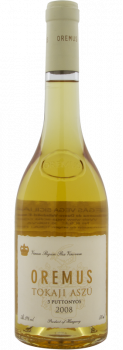Showing 1 to 12 of 12 (1 Pages)
Buy Wine from Tokaji
Tokaji, also known as Tokaj or Tokay, refers to the dry and sweet white wines made in the Tokaj-Hegyalja region of Hungary. Tokaji, was the first wine made from botrytized grapes even long before German sweet wines and French Sauternes.
The hills of Tokaji are ancient volcanoes where the lava, over hundreds of years, has turned into a thin layer of sand. Here the summers are hot and in autumn, the mountains protect the vineyard from the winds and the Bodrog and Tisza rivers favor the appearance of noble rot. The three white varieties used for the production of Tokaji wines are Furmint, Hárslevelu and Muscat Blanc à Petit Grains.
But how are Tokaji wines made?
Harvesting takes place in mid-October in order to manually harvest the aszú grapes (a term referring to grapes affected by botrytis cinerea) in strict order of selection. Those grapes free of rot are harvested separately to be vinified separately in order to obtain a dry (Tokay Szamorodni) or semi-dry (Tokay Szamorodni Edes) white wine.
The aszú grapes are de-stemmed, piled and kneaded in a press where they are left to rest for a week so that they gradually release the eszencia (concentrated juice nectar with a sugar concentration of up to 850 g/l). The winemaker then adds the aszú paste to the fully or partially fermented base wine and allows it to macerate for the next 24-36 hours. The wine is then racked into oak barrels where a second fermentation will begin, which will proceed more or less slowly depending on the sugar richness of the wine and the cellar temperature. Aszú wines must be aged for a minimum of three years, of which two in barrels and one in bottle.
The sweetness of Tokaji will depend on the amount of 20kg puttonyos added to 137 liters (one barrel) of base wine. So the more puttonyos the base wine has, the higher its sugar concentration: Escenzia is the most luxurious, noble and unctuous drink from the flower must generated by the stored aszú grapes. A nectar, which hardly ferments, of very low alcohol content known as the elixir of kings; Aszú-Eszencia is a wine of 7 puttonyos in which the second fermentation is minimal and the wine is of extreme quality; Aszú wine 6 puttonyos must have a concentration greater than 150 g/l; 4 and 5 puttonyos (between 120 and 150 g/l) is equivalent to a German Beerenauslese; and 3 puttonyos (between 60 and 90 g/l) is the equivalent of a German Auslese.
Any of them is a velvety delight for the palate where syrupy and honey notes emerge. Wines that, due to their high sugar concentration and backbone acidity, are great allies of long bottle ageing.
- ;
-
- ;
- ;
-
- ;
-
-
Buy Wine from Tokaji
Tokaji, also known as Tokaj or Tokay, refers to the dry and sweet white wines made in the Tokaj-Hegyalja region of Hungary. Tokaji, was the first wine made from botrytized grapes even long before German sweet wines and French Sauternes.
The hills of Tokaji are ancient volcanoes where the lava, over hundreds of years, has turned into a thin layer of sand. Here the summers are hot and in autumn, the mountains protect the vineyard from the winds and the Bodrog and Tisza rivers favor the appearance of noble rot. The three white varieties used for the production of Tokaji wines are Furmint, Hárslevelu and Muscat Blanc à Petit Grains.
But how are Tokaji wines made?
Harvesting takes place in mid-October in order to manually harvest the aszú grapes (a term referring to grapes affected by botrytis cinerea) in strict order of selection. Those grapes free of rot are harvested separately to be vinified separately in order to obtain a dry (Tokay Szamorodni) or semi-dry (Tokay Szamorodni Edes) white wine.
The aszú grapes are de-stemmed, piled and kneaded in a press where they are left to rest for a week so that they gradually release the eszencia (concentrated juice nectar with a sugar concentration of up to 850 g/l). The winemaker then adds the aszú paste to the fully or partially fermented base wine and allows it to macerate for the next 24-36 hours. The wine is then racked into oak barrels where a second fermentation will begin, which will proceed more or less slowly depending on the sugar richness of the wine and the cellar temperature. Aszú wines must be aged for a minimum of three years, of which two in barrels and one in bottle.
The sweetness of Tokaji will depend on the amount of 20kg puttonyos added to 137 liters (one barrel) of base wine. So the more puttonyos the base wine has, the higher its sugar concentration: Escenzia is the most luxurious, noble and unctuous drink from the flower must generated by the stored aszú grapes. A nectar, which hardly ferments, of very low alcohol content known as the elixir of kings; Aszú-Eszencia is a wine of 7 puttonyos in which the second fermentation is minimal and the wine is of extreme quality; Aszú wine 6 puttonyos must have a concentration greater than 150 g/l; 4 and 5 puttonyos (between 120 and 150 g/l) is equivalent to a German Beerenauslese; and 3 puttonyos (between 60 and 90 g/l) is the equivalent of a German Auslese.
Any of them is a velvety delight for the palate where syrupy and honey notes emerge. Wines that, due to their high sugar concentration and backbone acidity, are great allies of long bottle ageing.





